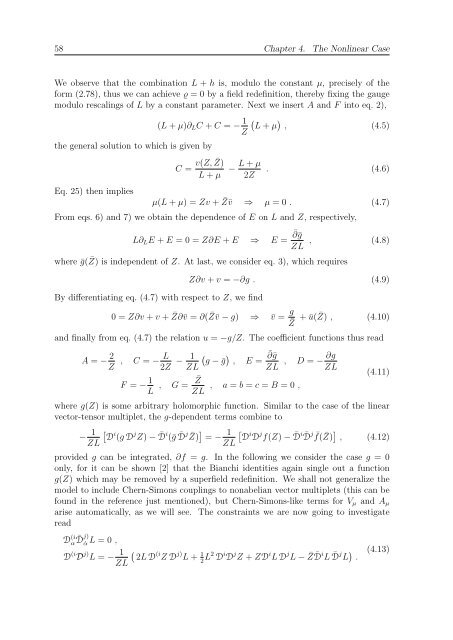N=2 Supersymmetric Gauge Theories with Nonpolynomial Interactions
N=2 Supersymmetric Gauge Theories with Nonpolynomial Interactions
N=2 Supersymmetric Gauge Theories with Nonpolynomial Interactions
You also want an ePaper? Increase the reach of your titles
YUMPU automatically turns print PDFs into web optimized ePapers that Google loves.
58 Chapter 4. The Nonlinear Case<br />
We observe that the combination L + h is, modulo the constant µ, precisely of the<br />
form (2.78), thus we can achieve ϱ = 0 by a field redefinition, thereby fixing the gauge<br />
modulo rescalings of L by a constant parameter. Next we insert A and F into eq. 2),<br />
the general solution to which is given by<br />
Eq. 25) then implies<br />
(L + µ)∂LC + C = − 1 <br />
L + µ , (4.5)<br />
Z<br />
C = v(Z, ¯ Z)<br />
L + µ<br />
− L + µ<br />
2Z<br />
. (4.6)<br />
µ(L + µ) = Zv + ¯ Z¯v ⇒ µ = 0 . (4.7)<br />
From eqs. 6) and 7) we obtain the dependence of E on L and Z, respectively,<br />
L∂LE + E = 0 = Z∂E + E ⇒ E = ¯ ∂¯g<br />
ZL<br />
where ¯g( ¯ Z) is independent of Z. At last, we consider eq. 3), which requires<br />
By differentiating eq. (4.7) <strong>with</strong> respect to Z, we find<br />
, (4.8)<br />
Z∂v + v = −∂g . (4.9)<br />
0 = Z∂v + v + ¯ Z∂¯v = ∂( ¯ Z¯v − g) ⇒ ¯v = g<br />
¯Z + ū( ¯ Z) , (4.10)<br />
and finally from eq. (4.7) the relation u = −g/Z. The coefficient functions thus read<br />
A = − 2<br />
Z<br />
, C = − L<br />
2Z<br />
F = − 1<br />
L , G = ¯ Z<br />
ZL<br />
1 ∂¯g ¯<br />
− g − ¯g , E =<br />
ZL<br />
ZL<br />
, a = b = c = B = 0 ,<br />
, D = − ∂g<br />
ZL<br />
(4.11)<br />
where g(Z) is some arbitrary holomorphic function. Similar to the case of the linear<br />
vector-tensor multiplet, the g-dependent terms combine to<br />
− 1 i j<br />
D (g D Z) − D¯ i<br />
(¯g D¯ j<br />
Z) ¯ 1 i j<br />
= − D D f(Z) − ¯ i<br />
D ¯ j<br />
D f( ¯ Z) ¯ , (4.12)<br />
ZL<br />
ZL<br />
provided g can be integrated, ∂f = g. In the following we consider the case g = 0<br />
only, for it can be shown [2] that the Bianchi identities again single out a function<br />
g(Z) which may be removed by a superfield redefinition. We shall not generalize the<br />
model to include Chern-Simons couplings to nonabelian vector multiplets (this can be<br />
found in the reference just mentioned), but Chern-Simons-like terms for Vµ and Aµ<br />
arise automatically, as we will see. The constraints we are now going to investigate<br />
read<br />
D (i<br />
α ¯ D j)<br />
˙α L = 0 ,<br />
D (i D j) L = − 1 (i j) 1<br />
2L D Z D L + 2 ZL<br />
L2 D i D j Z + ZD i L D j L − ¯ Z ¯ D i L ¯ D j L .<br />
(4.13)

















